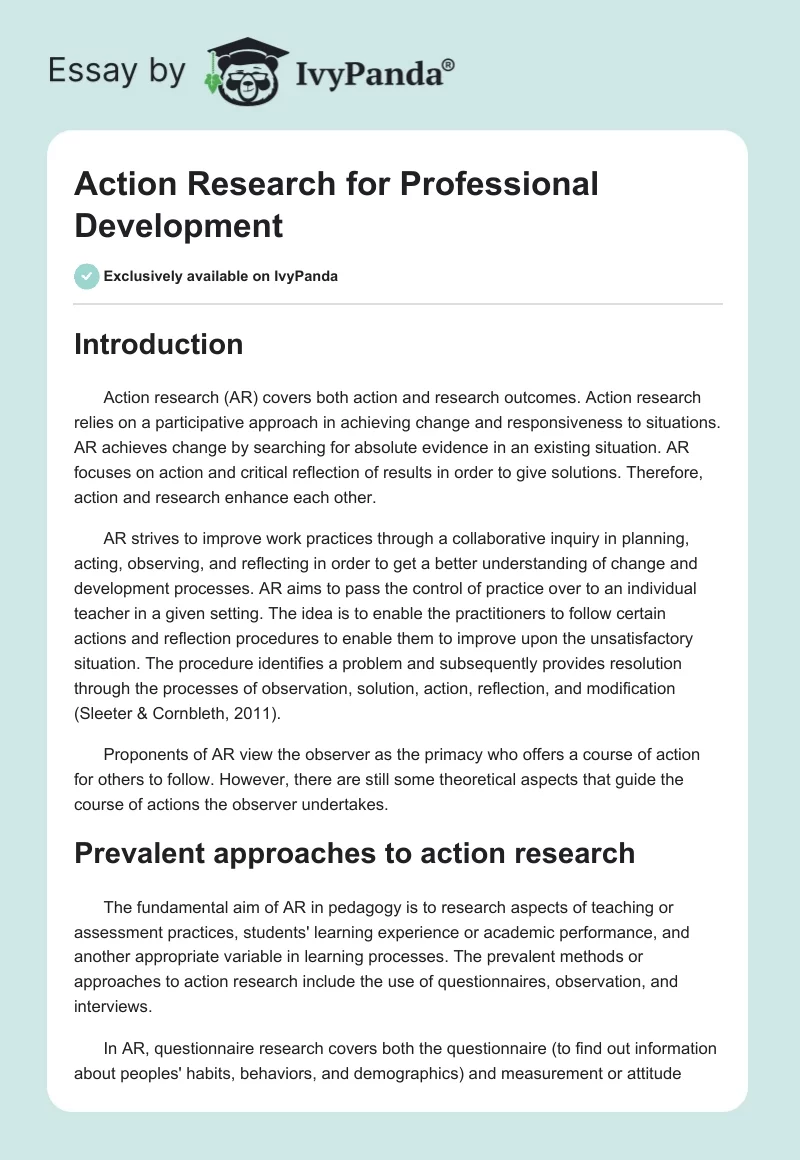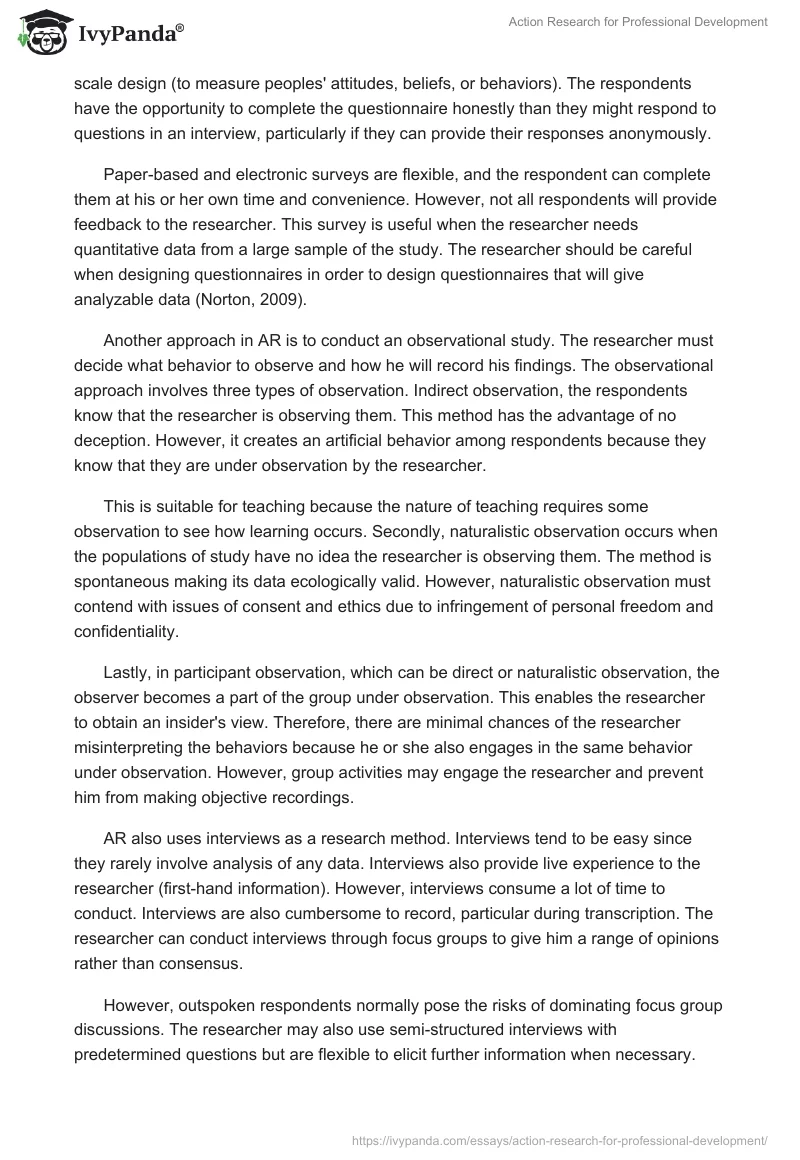Introduction
Action research (AR) covers both action and research outcomes. Action research relies on a participative approach in achieving change and responsiveness to situations. AR achieves change by searching for absolute evidence in an existing situation. AR focuses on action and critical reflection of results in order to give solutions. Therefore, action and research enhance each other.
AR strives to improve work practices through a collaborative inquiry in planning, acting, observing, and reflecting in order to get a better understanding of change and development processes. AR aims to pass the control of practice over to an individual teacher in a given setting. The idea is to enable the practitioners to follow certain actions and reflection procedures to enable them to improve upon the unsatisfactory situation. The procedure identifies a problem and subsequently provides resolution through the processes of observation, solution, action, reflection, and modification (Sleeter & Cornbleth, 2011).
Proponents of AR view the observer as the primacy who offers a course of action for others to follow. However, there are still some theoretical aspects that guide the course of actions the observer undertakes.
Prevalent approaches to action research
The fundamental aim of AR in pedagogy is to research aspects of teaching or assessment practices, students’ learning experience or academic performance, and another appropriate variable in learning processes. The prevalent methods or approaches to action research include the use of questionnaires, observation, and interviews.
In AR, questionnaire research covers both the questionnaire (to find out information about peoples’ habits, behaviors, and demographics) and measurement or attitude scale design (to measure peoples’ attitudes, beliefs, or behaviors). The respondents have the opportunity to complete the questionnaire honestly than they might respond to questions in an interview, particularly if they can provide their responses anonymously.
Paper-based and electronic surveys are flexible, and the respondent can complete them at his or her own time and convenience. However, not all respondents will provide feedback to the researcher. This survey is useful when the researcher needs quantitative data from a large sample of the study. The researcher should be careful when designing questionnaires in order to design questionnaires that will give analyzable data (Norton, 2009).
Another approach in AR is to conduct an observational study. The researcher must decide what behavior to observe and how he will record his findings. The observational approach involves three types of observation. Indirect observation, the respondents know that the researcher is observing them. This method has the advantage of no deception. However, it creates an artificial behavior among respondents because they know that they are under observation by the researcher.
This is suitable for teaching because the nature of teaching requires some observation to see how learning occurs. Secondly, naturalistic observation occurs when the populations of study have no idea the researcher is observing them. The method is spontaneous making its data ecologically valid. However, naturalistic observation must contend with issues of consent and ethics due to infringement of personal freedom and confidentiality.
Lastly, in participant observation, which can be direct or naturalistic observation, the observer becomes a part of the group under observation. This enables the researcher to obtain an insider’s view. Therefore, there are minimal chances of the researcher misinterpreting the behaviors because he or she also engages in the same behavior under observation. However, group activities may engage the researcher and prevent him from making objective recordings.
AR also uses interviews as a research method. Interviews tend to be easy since they rarely involve analysis of any data. Interviews also provide live experience to the researcher (first-hand information). However, interviews consume a lot of time to conduct. Interviews are also cumbersome to record, particular during transcription. The researcher can conduct interviews through focus groups to give him a range of opinions rather than consensus.
However, outspoken respondents normally pose the risks of dominating focus group discussions. The researcher may also use semi-structured interviews with predetermined questions but are flexible to elicit further information when necessary. This enables the researcher to understand the respondent’s point of view. Occasionally, AR uses unstructured interviews to enable the researcher to gain insight about the respondent’s experience and beliefs. Unstructured interview tends to be long, requires the trust of the respondent and expertise of the researcher. Finally, structured interviews have predetermined questions with the flexibility to clarify questions when respondents misinterpret or do not understand them (McNiff, 1993).
Action research distinctive paradigm
The fundamental paradigm of AR is that professionals can learn, gain, and create knowledge and theory on the basis of their concrete experience. This occurs through observation and reflection on experience, forming abstract conceptualizations and generalizations, and by testing the implications of these concepts in new situations. AR shows that the process of learning is not linear, unpredictable, unidirectional, but rather cyclical, recursive, continuing, exploratory, creative, flexible, ongoing and lifelong (Pine, 2009).
Action research consists of four cycles. Planning which includes problem and context analysis and design of a strategic plan to improve the situation. The next cycle involves action or implementation of the strategic plan. Once the researcher has implemented the strategic plan, he can observe i.e. systematic monitoring, obtaining feedback and evaluating the process. Finally, the researcher reflects on the results of evaluation critically for any new developments.
Action researcher may revise the original plan and go through the cycle until he achieves the desired outcome in the given time limit. Therefore, the idea of action research is not linear or theory-oriented like in the traditional research. Traditional research starts with theory or hypothesis, tests the hypothesis by restricting or reducing the social phenomena to confined and defined variables. The researcher confirms the hypothesis as right or wrong. However, AR is cyclical, problem-oriented, action-oriented, non-positivist and dialectical (results can be both right and wrong).
Research paradigm and research methods
Action research assumes several research approaches. A paradigm contains several methodologies. Every methodology in the paradigm uses a number of techniques for data collection and interpretation e.g. survey interviews and data analysis. Paradigm and research methods in action research work to complement each other.
The most common paradigm in action research is positivism, which seeks to find out the truth by use of surveys and experimental methods. Another paradigm is the interpretivism which argues that other methods force views on their subjects instead of gaining, describing and comprehending those world views. On the other hand, critical postmodernism states that these forced views absolutely support varied scientific knowledge that utterly result into capitalists structures responsible for inequality (McNiff, 1993).
Commercial and conventional professional development
Researchers can exploit action research at professional levels to create an education system appropriate to the demands of modernity in order to establish a foundation of knowledge and skill for all learners. This will nurture distinct talents of each child.
Conventionally, in a contemporary society, there are individuals struggling to obtain equality of opportunity and social justice in national education systems. Education systems can perpetuate or curtail education disadvantages for marginalized groups. Therefore, we can use findings of action research to address inequality in education systems. AR also looks at the gains and effects of special education to its pupils.
Action research through a critical reflection can transform individuals and community practices, both on personal and professional level. If we evaluate some implications of education systems, consider a research-based approach to teacher education and acknowledge the fact that we have to support this paradigm, we will be ready to change the educational systems and change the society (Sagor, 1992).
Argument in its defense of action research
Researchers conduct action research in order to improve their own situation. Actions researchers carry out a study to establish whether they can do better than the existing situation. Unlike other scientific researchers such as investigative journalism, which look at what others are doing or should be doing, action research looks at what the researchers themselves are doing or should be doing.
AR consists of elements of creativity and flexibility. Therefore, it is highly suitable in a workplace for dealing with the dynamic social and organizational issues in unprecedented situations. This is the reason why AR has gained intellectual and institutional attention.
The cyclical and collaborative nature of AR enables it to incorporate theory and practice, research and action into a single cyclic process. Action research is systematic, rigorous in its approach, and always presents its results to the public through publications. This enables peers to make use of the findings.
References
McNiff, J. (1993). Teaching as learning: An action research approach. New York: Routledge.
Norton, L. S. (2009). Action Research in Teaching and Learning: A practical guide to conducting pedagogical research in universities. New York: Routledge.
Pine, G. J. (2009). Teacher action research; building knowledge democracies. Boston: Sage Publications.
Sagor, R. (1992). How to Conduct Collaborative Action Research. Virginia: Association for Supervision and Curriculum Development.
Sleeter, C. E. & Cornbleth, C. (2011). Teaching with vision: Culturally Responsive Teaching in Standards-Based Classrooms. New York: Teachers College Press.


